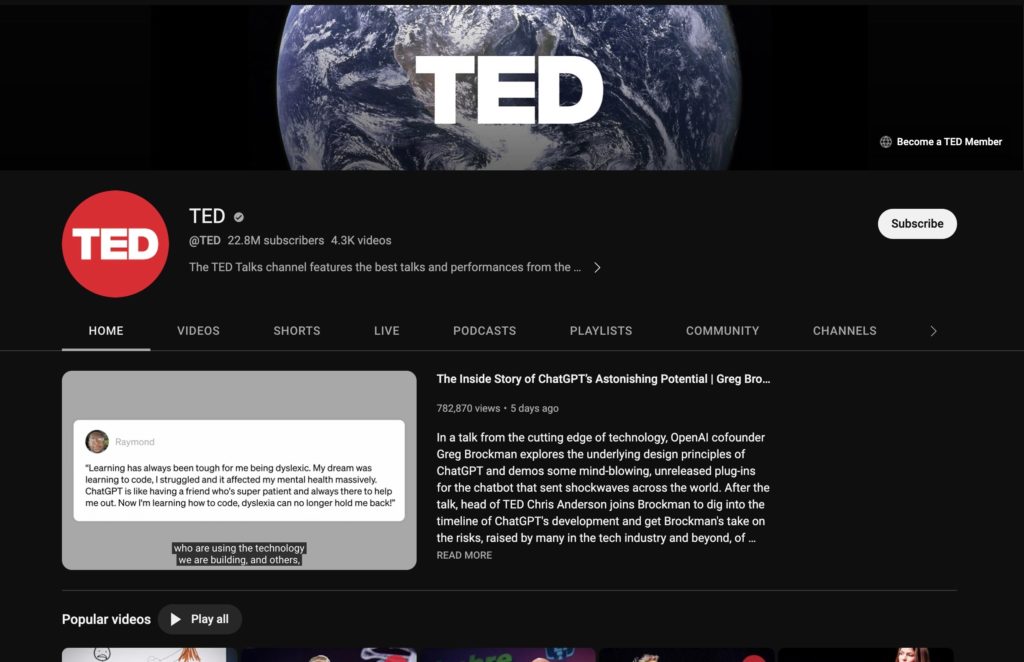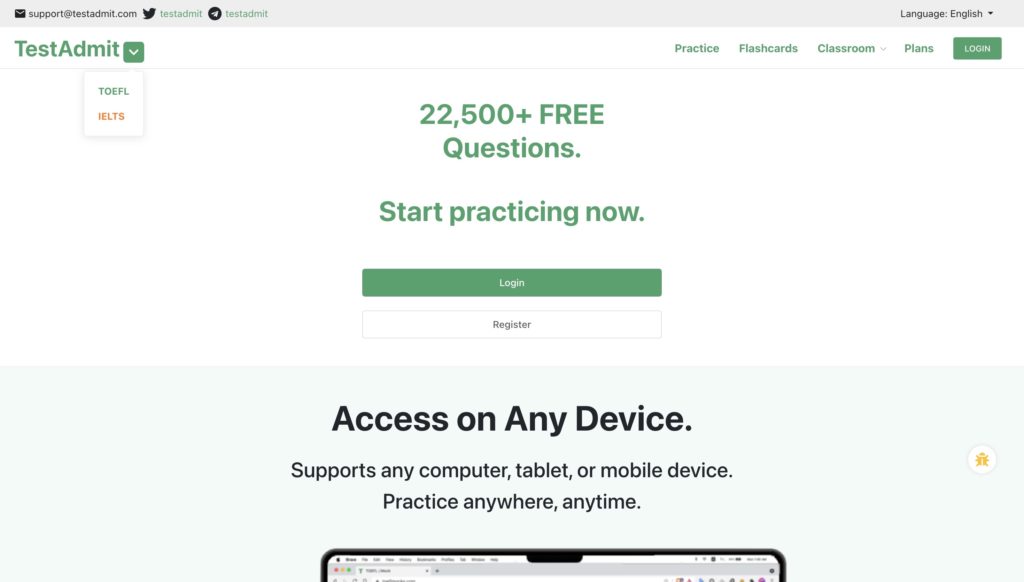托福聽力:題型、範例、答題技巧
托福聽力題型主要可以分為以下 7 種:主旨題、細節題、目的題、觀點題、組織結構題、內在關係題、推論題,以下會為大家一一介紹,每次考試中會出現其中幾種,並不會全部出現
托福聽力:主旨題 (Gist content)
主旨題主要考驗學生對於聽力內容的整體理解程度,考題通常會問到聽力考題的主旨、中心思想或大意,這種題型的答案通常可以在聽力考題中找到,因此學生需要仔細聆聽並找出最重要的訊息,點擊連結可以看到托福官方所介紹的主旨題範例!
範例:
What is the main idea of the lecture?
(A) The professor’s opinion on environmental pollution.
(B) The negative effects of pollution on the environment.
(C) The different sources of environmental pollution.
(D) The need for more action to solve environmental pollution.
主旨題答題技巧
以下用一個聽力測驗逐字稿來說明答題技巧,當你聽到
“An increasing number of companies are choosing to incorporate remote work options into their business model. This trend is driven by the desire for better work-life balance, increased flexibility, and the need to attract and retain top talent. However, remote work arrangements also pose challenges, such as a lack of face-to-face interaction and communication issues. Despite these challenges, remote work is expected to continue to grow in popularity in the coming years.”
答題技巧一:抓出關鍵字與次要訊息
像上方所提到的關鍵詞包括”remote work options”、”work-life balance”、”flexibility”、”top talent”、”challenges”和”popularity”。
答題技巧二:用自己的話來總結,中文英文都可以
像上方的內容就可以用自己的話來寫成如:More and more companies are starting to offer remote work options because it provides better work-life balance, increases flexibility, and helps attract and retain top talent. Despite the challenges, remote work will continue to be popular.
托福聽力:細節題 (detail questions)
主要考察學生對於聽力題目中細節的理解程度,考題通常會問到關於聽力題目中的具體訊息,例如人物、地點、時間、事件等,這種題型需要學生專注聆聽聽力題目中的細節,因此學生需要對聽力題目進行細致的分析,點擊連結可以看到托福官方所介紹的細節題範例!
範例:
What time does the library close on Fridays?
(A) 6:00 p.m.
(B) 7:00 p.m.
(C) 8:00 p.m.
(D) 9:00 p.m.
細節題答題技巧
答題技巧一:做筆記,記下關鍵字
在聆聽托福聽力時,學生需要注意聽力問題中提到的關鍵詞,例如人物名稱、地點名稱、時間、事件等,這些信息可以幫助學生更好地理解聽力問題並回答相關問題。例如,在一段談論環保的聽力材料中,如果出現關於「climate change」這個關鍵詞,學生就應該記下來,因為這個詞彙可能會在後面的問題中出現。
托福聽力:目的題 (function questions)
主要考察學生對於聽力材料中語言行為的理解程度。考題通常會問到聽力材料中人物的意圖、目的或意義,例如請求、建議、批評等。這種題型需要學生理解聽力材料中的語言行為,因此學生需要關注人物的語氣、表情和用詞,點擊連結可以看到托福官方所介紹的目的題範例!
範例:
目的題逐字稿:
Professor: Hi, Sarah. You wanted to see me?
Sarah: Yes, Professor Johnson. I just finished writing my research paper for your class.
Professor: Great. What’s your topic?
Sarah: I chose to write about the impact of social media on mental health.
Professor: Interesting. And what was your main argument?
Sarah: Well, I argued that social media can have both positive and negative effects on mental health, but it ultimately depends on how it’s used.
問題:
What was Sarah’s main argument in her research paper?
- Social media has a negative impact on mental health.
- Social media has a positive impact on mental health.
- The impact of social media on mental health is unclear.
- The impact of social media on mental health depends on how it’s used.
目的題答題技巧
答題技巧一:注意人物的語氣,來推斷他們的目的和意圖
在聽取聽力材料時,學生需要注意人物的語氣和表情,例如是否感到激動、生氣、開心或是焦慮等等。透過人物的語氣和表情,可以推斷其意圖和目的,例如是否在請求、批評、建議等等。
答題技巧二:注意人物使用的詞語
有時候人物會使用特定的詞語或詞組,來表達他們的意圖或目的。因此,學生需要聆聽這些詞語或詞組,以推斷其意圖或目的,下方為大家整理出一些常見的特定詞語
- Request:請求
- Suggest:建議
- Criticize:批評
- Agree/Disagree:同意/不同意
- Explain:解釋
- Emphasize:強調
- Advise:勸告
- Conclude:結論
- Clarify:澄清
- Object:反對
- Agree to disagree:同意有不同看法
- Outline:概述
- Recap:回顧、總結
- Summarize:總結、概括
- Predict:預測
托福聽力:觀點題 (Attitude questions)
主要考察學生對於聽力問題中人物觀點的理解程度,考題通常會問到聽力問題中人物對某個話題的看法、態度或感受,這種題型需要學生理解聽力問題中人物的觀點和立場,因此學生需要注意聽力材料中的表達方式和語氣,點擊連結可以看到托福官方所介紹的觀點題範例!
範例:
觀點題逐字稿
A: I heard you’re thinking about studying abroad next semester. Where are you thinking of going?
B: Well, I’ve been looking at a few different programs, but I’m really interested in the one in Spain.
A: Spain? That sounds exciting! Why Spain?
B: Well, I’ve always been interested in learning Spanish, and I think it would be a great opportunity to immerse myself in the language and the culture.
問題:
What is the speaker’s attitude towards studying abroad in Spain?
(A) Excited
(B) Indifferent
(C) Displeased
(D) Concerned
觀點題答題技巧
答題技巧:理解上下文
考生需要理解整段聽力對話的上下文,以推斷人物的意圖或目的。聽力對話中的一句話可能不足以理解人物的意圖或目的,因此需要理解整段對話的上下文。學生需要注意人物的前後對話內容,以及事件的背景和情境等等。
托福聽力:組織結構題 (Organization questions)
主要考察學生對於聽力對話中組織結構的理解程度,考題通常會問到聽力對話中的段落組織、邏輯順序或架構,這種題型需要學生對聽力材料中的組織結構進行分析,因此學生需要注意聽力材料中的轉折詞、信號詞和關鍵詞,點擊連結可以看到托福官方所介紹的組織結構題範例!
範例
組織結構題逐字稿
Today we’re going to talk about modern architecture. First, let’s go over some of the characteristics of modern architecture. As you may know, modern architecture emerged in the early 20th century, and it was characterized by the use of new construction materials and techniques, such as steel and reinforced concrete. These materials allowed for new forms and structures that were not possible before. Additionally, modern architects placed a greater emphasis on function over form. They believed that buildings should be designed to meet the needs of their occupants, rather than following traditional styles or forms. Finally, modern architects also embraced technology as a way to solve design problems and create new forms. For example, many modern buildings incorporate advanced HVAC systems that allow for greater energy efficiency and indoor comfort. However, as we move forward, it’s becoming increasingly important for architects to also prioritize sustainability in their designs, so that we can ensure a healthier environment for future generations.
問題:
What is the lecture mainly about?
(A) The history of modern architecture.
(B) The characteristics of modern architecture.
(C) The importance of sustainability in modern architecture.
(D) The role of technology in modern architecture.
組織結構題答題技巧
答題技巧:注意轉折詞、信號詞、關鍵詞
以下替大家整理了一些托福組織結構題常出現的轉折詞和信號詞
信號詞
- First of all:首先、第一點
- Secondly:其次、第二點
- In addition:此外、加之
- Furthermore:而且、此外、進一步地
- Moreover:此外、而且、加之
- Similarly:同樣地
- Likewise:同樣地、同樣地說
- However:然而、可是
- Nevertheless:然而、儘管如此
- Nonetheless:然而、儘管如此
- On the other hand:另一方面
- In contrast:相比之下、對比之下
- Nevertheless:然而、儘管如此
- In fact:事實上
- Indeed:確實、實際上
轉折詞
- But:但是、可是
- However:然而、可是
- Although:儘管、雖然
- Despite:儘管、不管
- Even though:即使、雖然
- While:雖然、然而、同時
- Whereas:然而、相比之下
答題技巧:注意對話中的段落結構
聽力對話中的段落結構和內容是理解整個聽力內容的重要組成部分,大家應該注意每個段落的主題句和佐證,以確定段落的主要內容。同時,學生應該注意段落之間的關係和過渡,以理解聽力對話的整個組織結構。
托福聽力組織結構題常見的結構是:主題句/佐證一/佐證二/結論
托福聽力:內在關係題 (connecting content questions)
內在關係題主要考察學生對聽力內容的理解程度,以及對相關資訊之間的關係的理解程度,這種題型通常會要求學生理解和記住聽力對話中的細節和主旨,並通過將它們組合起來,確定它們之間的內在關係,例如比較、對比、因果關係等。為了應對這種題型,學生需要專注於聆聽細節並理解上下文,以確保他們能夠準確地捕捉到對話中的關鍵信息,並理解它們之間的關係,點擊連結可以看到托福官方所介紹的內在關係題範例!
範例:
內在關係題逐字稿
Man: Hey, I was thinking about heading out for lunch in a little while. Do you want to join me?
Woman: Sure, I’d love to. Where were you thinking of going?
Man: Well, there’s a new sushi place that just opened up downtown. I’ve heard some good things about it.
Woman: Oh, sushi sounds great. But I’m a little tight on cash right now, so maybe we could go somewhere a little cheaper?
Man: No problem. There’s a Vietnamese place a couple of blocks away that’s really good and not too expensive.
問題
Why did the woman suggest going somewhere cheaper for lunch?
(A) She doesn’t like sushi.
(B) She is low on money.
(C) She prefers Vietnamese food.
(D) She wants to try a new place.
內在關係題答題技巧
答題技巧:注意轉折詞與信號詞
轉折詞和信號詞可以幫助你理解對話中的相關資訊之間的關係。例如,”but”表示相反的想法,”however”表示轉折的想法,”therefore”表示因果關係等。
答題技巧:理解上下文
考生需要理解整段聽力對話的上下文,以推斷人物的意圖或目的,只聽一句話可能不足以理解人物的意圖或目的,因此需要理解整段對話的上下文。學生需要注意人物的前後對話內容,以及事件的背景和情境等等
托福聽力:推論題 (Inference questions)
推論題主要希望考學生通過理解聽力對話中的資訊,從中推斷出未直接提及的資訊,這種題型通常會要求學生根據聽力對話中的資訊推斷出相關的結論或做出相關的推論,為了應對這種題型,學生需要理解聽力對話中的資訊,包括意義和重要性,並學會根據這些資訊進行推斷和分析。學生還需要注意聽力對話中的細節,並將它們與其他資訊相結合,以推斷出未直接提及的資訊,點擊連結可以看到托福官方所介紹的推論題範例!
範例:
推論題逐字稿
Student: I’m considering studying abroad to improve my language skills. Do you think it’s worth it?
Professor: Well, it can be a great opportunity to immerse yourself in a new culture and practice your language skills. However, it’s not a guarantee that you’ll come back fluent in the language. You have to be proactive and make an effort to use the language as much as possible while you’re there.
問題
What can be inferred about the professor’s opinion on studying abroad for language learning?
(A) Studying abroad is not an effective way to learn a language.
(B) Studying abroad is the best way to become fluent in a language.
(C) Studying abroad can be a beneficial way to learn a language, but it requires effort on the student’s part.
(D) The professor does not have an opinion on studying abroad for language learning.
推論題答題技巧
答題技巧:利用對話中的的暗示
在聽力對話中,有時會有一些隱藏在言語之下的暗示或提示,學生需要留意並抓住這些暗示或提示,以幫助自己推斷出未直接提及的資訊。例如,在一段關於旅行的對話中,對話中的一方可能會提到自己喜歡到海邊玩,但是在當地住宿很難找,這時聽眾就可以推斷出這個地方的旅遊資源很豐富,但是當地的住宿資源可能不足。
答題技巧:將聽力對話中的資訊進行組合
在聽力對話中,學生可以通過將不同的資訊進行組合,從而推斷出未直接提及的資訊。例如,在一段關於學校教育的對話中,對話中的一方可能提到學校近年來開始加強STEM課程的教學,另一方則提到學校正在為學生提供更多的實習機會,學生可以通過將這些資訊進行組合,推斷出學校正在加強STEM課程的教學,是為了幫助學生更好地應對未來的職場需求。
3 大托福聽力練習方法
在了解到托福各聽力題的範例與答題技巧後,在這邊提供大家 3 個平常練習托福聽力的方法
聽完對話或演講後用自己的話進行複述和總結
在聽完對話或演講後,嘗試回憶和複述你所聽到的內容,並總結主要的觀點和信息,這種練習有助於加深你對聽力題目的理解和記憶,並幫助你更好地掌握關鍵信息和細節。例如,你可以聽一段自己有興趣的演講,然後嘗試用自己的話概括和回顧演講者的主要論點和佐證的例子。
利用單字和語法知識推斷意義
有時候,在聽力測驗中出現的一些單字或句子可能是你不熟悉的,但是你可以根據上下文和語法規則推斷出它們的意義。這種練習可以幫助你提高對語言的敏感度和理解力,練習方法可以是,隨後聽一段對話,遇到一個你不熟悉的詞彙,可以根據前後的語境和其他相關訊息來推斷出它的意義。
練習做筆記抓關鍵字
在聽力測驗中,可能會有一些重要的信息和細節需要注意,因此練習聽力筆記是非常有必要的。在聽力材料播放的過程中,嘗試記錄下你認為重要的關鍵詞、名詞、動詞和形容詞,這樣有助於你在之後更好地複述和總結聽力材料。例如,你可以聽一段對話或演講,嘗試記錄下關鍵詞和重要信息,如數字、名詞、動詞和形容詞等。
托福聽力學習資源推薦
托福聽力學習資源推薦: TED Talks

推薦指數:⭐⭐⭐⭐⭐⭐
TED Talks 非常適合托福聽力的練習,因為講者通常會談論到世界各地的文化、科技、社會等主題,而這些主題也是托福聽力的考點之一。此外,TED Talks 通常以講者清晰、有條理的演講成名,有利於考生培養抓取聽力重點的能力。
優點
- 素材多樣性佳,幫助考生熟悉各領域的知識
- 難度較高,TED Talks 通常會使用高難度單字和複雜的句型,對於有一定英語基礎的學生來說是一個很好的聽力挑戰,可以幫助學生提高聽力水平。
- 學習演講技巧和思維模式可以給學生提供參考和啟發,幫助學生更好地表達自己的想法和觀點,幫助托福口說考試
托福聽力學習資源推薦:TestAdmit

推薦指數:⭐⭐⭐⭐⭐⭐
優點
- 提供超過 22500 免費題目,超過 70 回完整托福考試題目,聽說讀寫都能練
- 介面與真實考試完全相同,模擬考試情況
- 考後提供程度分析
- 每題皆提供詳解
- 完整考試/單獨練習都可以
- 介紹完整考試形式、評分標準、考試內容
托福聽力學習資源推薦:BBC Learning English

推薦指數:⭐⭐⭐⭐⭐
BBC Learning English 提供了大量的免費練習資源,包括有聲文章、短片、測試和練習題,這些資源都針對雅思聽力的考試內容進行了精心設計。考生可以從中學習各種不同的主題,例如科技、文化、環境、經濟等,並且可以提高聽力理解和解題能力。
優點
- 主題多樣化,能夠依據自己喜歡的主題進行學習
- 提供針對聽力的練習題,包括聽力測試、聽力練習題和答案解析等,這些練習能夠幫助你更好地理解聽力題目,提高你的聽力能力。
- 提供新聞、故事、脫口秀、對話、訪談等不同類型的英語聽力素材,能夠幫助你熟悉不同口音、語速和語調,提高你的聽力理解能力。


